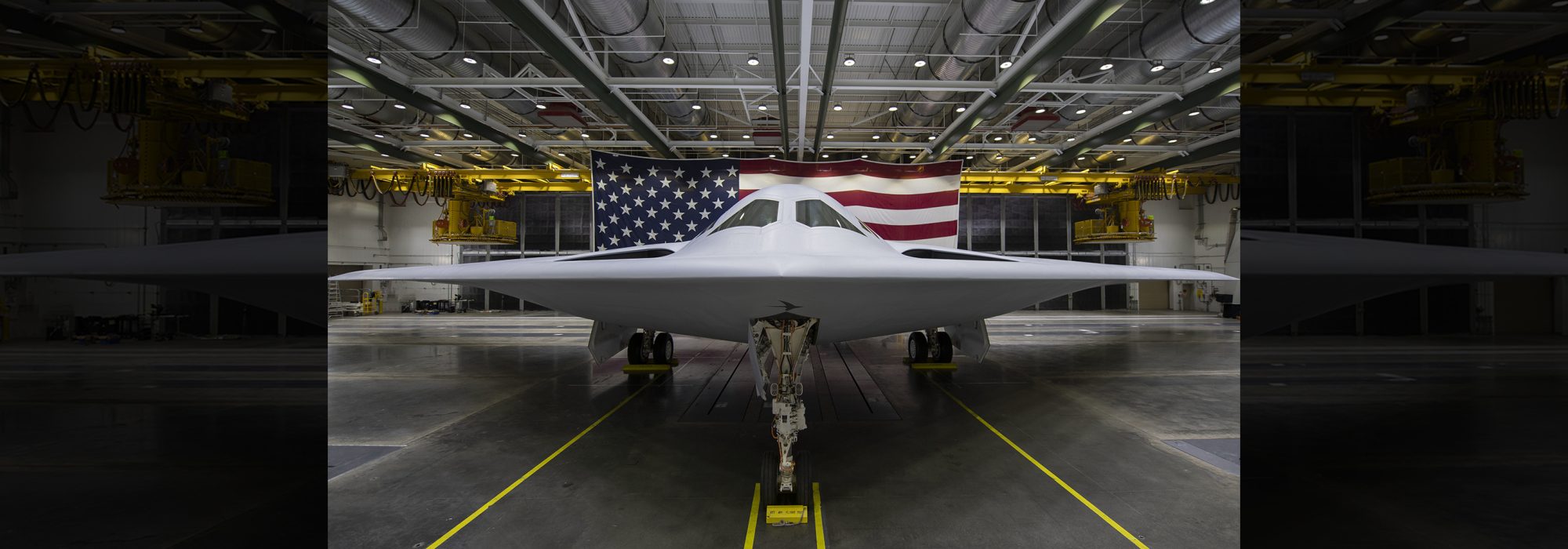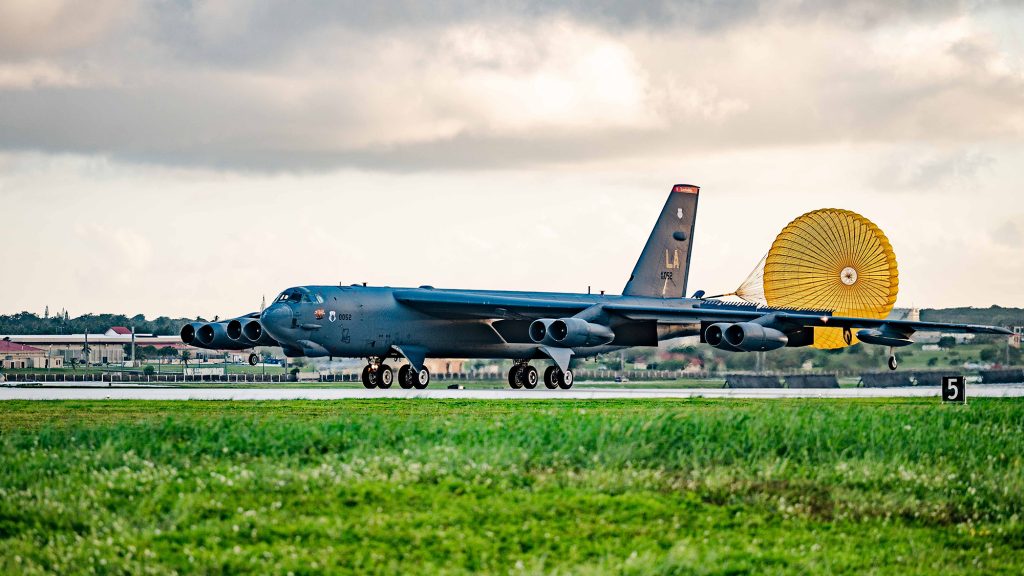Global Strike
The Air Force’s primary platform for air attack against the most heavily defended targets will be the sixth-generation B-21 Raider, featuring a degree of stealth “orders of magnitude” stealthier than the B-2A Spirit it will replace.
Like the B-2, the B-21 is being built by Northrop Grumman, but unlike its predecessor, it will feature an open systems architecture, enabling the Air Force to plug in upgrades from potentially any supplier. The Air Force, not Northrop, will own the technical baseline of the bomber, allowing any capable competitor to offer improvements to its electronic warfare systems, weapons, and software.
CHALLENGE: Our long-range strike capacity must be resilient against advanced threats with increasing range and sophistication but also affordable.


APPROACH: The U.S. will need to supplement current and next-generation, crewed platforms with lower-cost complementary uncrewed systems. The technologies are available now to introduce uncrewed aircraft in the system-of-systems context, both at the tactical level with NGAD and at the more strategic level with the B-21.
The B-21 will replace the B-1B Lancer and the stealthy B-2A Spirit, both slated to retire from front-line service in the early 2030s. Though structural analyses indicate that the B-1 and B-2 could conceivably serve into the 2040s, Air Force Global Strike Command foresees keeping two bomber types rather than four, with a fleet consisting of at least 100 B-21s and 76 B-52Js.
Even that fleet, though bigger than today’s bomber force, may be too small. Past AFGSC commanders and other experts say 145 B-21s is the minimum needed to sustain the necessary operational tempo in a future air campaign against a peer adversary. AFA’s Mitchell Institute for Aerospace Studies argues for 225, for a total bomber force of 300, including 75 B-52s.
Mitchell posits that in a theater war with China, with an initial target list of at least 100,000 aimpoints, only stealthy bombers delivering direct-attack weapons can achieve those kinds of numbers with any kind of efficiency.
The first B-21 program “usable asset” is anticipated circa 2025, but initial operational capability, which is classified, may be later. Production capacity is said to be limited to about 12 aircraft per year; any more than that would require significant added tooling and workforce investments, according to Air Force and Northrop Grumman officials.
While development of the B-21 is being conducted under a cost-plus contract, production will be under a fixed-price deal not to exceed $550 million per copy in 2010 base year dollars, or about $772 million adjusted for inflation.
Air Force and congressional leaders have praised the B-21 for being on-time and on-budget, but its first flight is now more than a year behind initial estimates. The first plane rolled out in December 2022, but no engine runs or taxi tests have been acknowledged yet; the Air Force still predicts first flight before the end of this year.
Air Force Secretary Frank Kendall, Air Force Chief of Staff Gen. Charles Q. Brown Jr., and Chief of Space Operations Gen. B. Chance Saltzman have described the sixth Operational Imperative as focused on “ways to improve the cost-effectiveness of the family of systems surrounding the B-21 bomber.”
The B-21 is “more than a new platform,” they wrote in their fiscal 2024 posture statement. The sixth OI identifies “new weapons, sensors, and communications that can make the B-21 more effective in the joint tactical fight,” particularly to deliver “precision weapon effects en masse to numerous targets anywhere in the world.”
B-52s Forever
Along with the new B-21, the Air Force is extending the life of the B-52H Stratofortress with a new radar from Raytheon, new Rolls-Royce engines, and new navigation, networking, communications and weapons, all integrated by Boeing. The 76 B-52s, once upgraded, will be designated B-52Js, and will all have completed the upgrade by the early 2030s. They are then expected to remain operable into the 2050s, approaching 100 years of age before they retire.
Armed with new nuclear-armed AGM-181 Long-Range Standoff (LRSO) missiles and a variety of conventional standoff weapons, the B-52Js will be able to operate at standoff ranges early in a conflict and later as a direct-attack bomber once air superiority is reached. It will also perform minelaying and anti-ship missions.
Plans to arm the B-52 with the Air Force’s first operational hypersonic missile—the AGM-183 Air-launched Rapid-Response Weapon (ARRW)—have now been canceled. A second hypersonic effort, the developmental Hypersonic Attack Cruise Missile (HACM), and other classified long-range conventional weapons are in the pipeline.
Equipping the B-52J with a version of the radar used in the Navy’s F/A-18E/F fighter is the first element of the B-52J upgrade, with initial operational capability expected in 2027. The engine replacements, featuring Rolls-Royce F130 engines in place of the original Pratt & Whitney TF33s, will begin about 2028, with the entire fleet to be equipped by 2035.
New Weapons
The stealthy AGM-181 LRSO, developed by Raytheon Technologies, will succeed the 50-year-old AGM-86B Air-Launched Cruise Missile (ALCM) around 2030. Aboard the B-52J, it will complement the B-21 as an airborne strategic deterrent. Air Force leaders have said a conventional variant could be a possibility. A portion of the ALCM inventory was converted to Conventional ALCMs, some of which were used in the 1991 Gulf War. Those weapons were the first operational missiles to use the Global Positioning System for targeting.
Strategic-Range Uncrewed Systems
A 2022 summary of the seven Operational Imperatives said, “The U.S. will need to supplement current and next-generation, crewed platforms with lower-cost complementary uncrewed systems.” This concept has been part of the B-21 “family of systems” since the program’s start, but how the Air Force plans to pursue this approach has never been explained in detail.
The Air Force’s summary says that “this initiative, similar to the initiative associated with the NGAD [Next Generation Air Dominance] system, has to do with identifying the components of a B-21 family of systems, including uncrewed combat aircraft.” It goes on to say that long-range strike capacity must be “resilient against advanced threats with increasing range and sophistication” and must be “affordable.”
Autonomous, uncrewed aircraft for this application “are available now … both at the tactical level with NGAD and at the more strategic level with the B-21,” the Air Force said.
Secretary Frank Kendall initially spoke of strategic-range uncrewed aircraft to enable and supplement the B-21, but later said that idea was not cost-effective.
Analysis showed that taking the crew out of a small, tactical aircraft deliver significant savings, but those savings do not scale for a large, long-range bomber, where crew support costs are “a small fraction of the [overall] cost,” he said.
Still, that does not rule out the use of uncrewed collaborative aircraft that might help enable the B-21 to penetrate hostile airspace, even if they do not continue deep into enemy territory. The B-21 itself was contracted to be an “optionally manned” system, meaning that it could be enabled to fly without a crew. The Air Force says it has not removed this requirement.
The future years defense plan calls for investing $20 billion in B-21 production through 2028, plus another $13 billion for research, development, testing, and evaluation.

